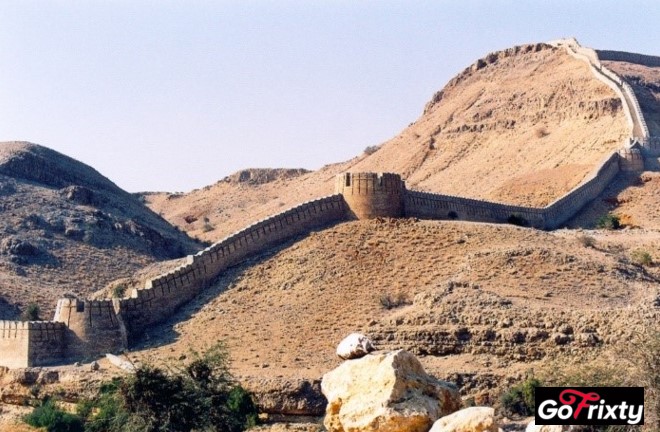Ranikot Fort OR (Rannikot Qilla) is a priceless historical heritage site in Sindh; also known as the great wall of Sindh. Ranikot Fort is a historical Talpur fort located near Sann, District Jamshoro, Sindh, a province of Pakistan.
Ranikot Fort is also known as the Great Wall of Sindh. It is because the ‘Fort’ is 32 KM large, and thus the area count in the world’s largest Forts ever made in the history of mankind. The historians and tourists call this priceless heritage of Sindh as the great wall of Sindh, it is because they see many similarities of the heritage with a great wall of China.
How to Locate Ranikot Fort?
Ranikot Qila is located at 90 KM in North of Hyderabad City. A very sandy and rough track joins it with the Indus Highway near the Sann Railway Station. The wall which is over 22 miles in length infolds hills which appear to have never been populated. Ranikot is at a distance of around 2 hours’ drive from District Hala (The Land of Bhit Shah, Shah Abdul Latif Bhittai). Kirtar National Park and Indus River are just located along with the Fort.
When to Visit Ranikot
It’s highly recommended to visit this priceless meritorious place in between October and March. Never recommended visiting in summers. If still any tourist plan to visit in Summers, it is recommended to get plenty of drinking water. There is generally a 30 KM drive from the National Highway and inside of the wall, there are more than 6 small forts inside which are not easily accessible. A tourist might need to walk around 10 to 15 KM for accessing every precious point inside the great wall of Sindh. A local tour guide is highly recommended.
Getting In and Around
You need to drive a jeep to see all of Ranikot, and can also camp overnight with the tour guides. The entry to the Fort is through the Sann Gate. Climb up on both sides for a beautiful view of the landscape. More down the road there is a small fortress, “Meeri”, housing the royal quarters. From there you can see another fortress named “Shergarh” up in the mountain. After driving and walking some more, head over to Mohan Gate. There are a number of valleys inside the fort, and small rain-streams used by the Spring villagers residing inside the fort. The ‘paryun jo talao’ (the pool of brownies) pool is quite deep and the stones around it are slippery. Beside Sann and Mohan Gates, there are two additional gates ‘Amri Gate’ and ‘Shahpar Gate’.
The History of Ranikot Fort
The original purpose and designers of Ranikot Fort is yet undiscovered. Some archaeologists attribute it to Arabs or possibly built by the Persians descent under the Abbasids by Imran Bin Musa Barmaki, who was the Governor of Sindh in 836 A.D. Others have suggested a much earlier period of construction attributing to either the Sassanians, Persians or the Greeks. Despite the fact that an ancient place of Amri is nearby, there is no suggestion of any old city inside the fort and the present structure has little evidence of prehistoric origins.
Archaeologists said that first building was constructed in 17 century, but now Sindh archaeologists agree that some of the present structure was rebuilt by two brothers Mir Karam Ali Khan Talpur Baloch and Mir Murad Ali Baloch in 1812.





The ranikot fort is the best place in the Pakistan because it is the Oldest and Largest wall of Pakistan
That from foreigns and outsider visit this place,the original architects has unknown , and it is located in Jamshoro Sindh Pakistan,and Ranikot Fort is not only fail to care for by scientists. Until recently the Pakistani government has made no any movement in promoting the Ranikot Fort as a visitors attract as the touristors can enjoy the place and know about the Pakistan history.
Ranikot Fort is the 3rd-longest Fort in the world which have (26,000 m). Among the top 10 longest buildings that are: Great Wall of China, Kumbhalgarh, Ranikot Fort, Diyarbakir Wall, Walls of Ston, Prora, LIGO-Livingston, Klystron gallery above the Stanford Linear Accelerator, Fenestrelle Fort, Three Gorges Dam
The ranikot fort is the best place in the Pakistan because it is the Oldest and Largest wall of Pakistan
That from foreigns and outsider visit this place,the original architects has unknown , and it is located in Jamshoro Sindh Pakistan,and Ranikot Fort is not only fail to care for by scientists. Until recently the Pakistani government has made no any movement in promoting the Ranikot Fort as a visitors attract as the touristors can enjoy the place and know about the Pakistan history.
Ranikot Fort is the 3rd-longest Fort in the world which have (26,000 m). Among the top 10 longest buildings that are: Great Wall of China, Kumbhalgarh, Ranikot Fort, Diyarbakir Wall, Walls of Ston, Prora, LIGO-Livingston, Klystron gallery above the Stanford Linear Accelerator, Fenestrelle Fort, Three Gorges Dam
Ranikot Fort A historical Talpur fort near Sann, Jamshoro District Sindh Pakistan.The Great Wall of Sindh .Archaeologists point to the 17th century as the time of its first construction but Sindh archaeologists now agree that some of the present structures were reconstructed by Talpurs in 1812 at a cost of 1.2 million rupees (Sindh Gazetteer, 677) The battlements of Ranikot formed the last capital of the Amirs of Sind, when they were brought under the colonial rule of the British Empire.Radiocarbon tests were conducted at the Sann Gate on the charcoal embedded in the mortar of the collapsed pillar of the eastern gate of the fort. These tests have confirmed that this gate was probably renovated between the early part of the 18th century and the early part of the 19th century, prior to Britain invading the fort when the Kalhoras, or most likely the Talpur Mirs of Sindh ruled over the area.Actually the sample for the radiocarbon test was gotten from the pillar which was constructed is later period and it is was not part of original and earlier Construction of the fort.
No wonder the place is empty of tourists: It is near Dadu which has a famous reputation as the capital of banditry.
All Muslim countries are very rich in historical civilizations and all those civilizations destroyed by Non-Muslim countries and enemies of Muslim,,
The wall is about 26 kilometers in circumference.inside the fort are two small forts. Marikot and Shergarh.,
One cannot imagine specially China Great wall because of the length that how they maintain to build up specially cutted & finishing of stones 5000 years ago. Here some people said that a part of China great Wall is in Pakistan that is Ranikot..
Well known historical sight Ranikot is located near San district Jamshoro in Sindh province. It is not sure who actually built this fort but it is known as Great Wall of Sindh.
The author Sana covered all aspects of the fort brierley. It is complete guide for tourists to visit this unique historical sight. She explained and tried to prove that this is one of the largest fort in the world. The name “Great Wall of Sindh ” is given by the tourists who visited the Great Wall of China before visiting it.
One of the best things I found in the article is that author suggested the season of winter and spring to visit it because we all know that the weather during summer becomes very hot, she also indicated the routes to reach there by road.
Author Sana quoted the views of various archaeologists about the history of the sight and the rules ruled the area. It has been explained brierley the internal structure of the fort. It is interesting for geologists and other experts that there are many parts of the fort is still to be discovered which will be helpful for new research and studies for experts as well as the students of the archaeology and history.
Ranikot Fort
This article tells us about the history .
This sight is totally archaeologists point to the 17th century as a teme of its first construction but sindh archeologist now agree that some of the present structure were reconstructed by talpurs .
The fort is huge connecting several bleak mountains of the kirthar hills.
The forts wall is interspersed with sevral bastions and 3 are samicercular shape the northam part of the forts perimetere is a naturnal highhilly formation while on the other 3 sides it is covered by fort walls .
With in this main fort there is a smaller fort known as the miri fort which is about three kilo meters from the sann gate.
This gate is also the entrance to the meeri
The best Artical about the Wall of Sindh, its very good place for visit. This article is all about the history of that state which is no more now.
Ranikot Fort is a historical Talpur fort near Sann, Jamshoro District, Sindh, Pakistan. Ranikot Fort is also known as The Great Wall of Sindh and is believed to be the world’s largest fort, with a circumference of approximately 32 kilometres. The fort’s ramparts have been compared to the Great Wall of China.
Thanks a bunch for sharing this with all of us you actually know what you’re talking about! Bookmarked. Please also visit my website =). We could have a link exchange agreement between us!
[…] is home to many naturally beautiful places in the world, like Gilgit Baltistan, Swat, Azad Kashmir, Ranikot Fort and Mohen Jo Daro in Sindh, Ziarat valley in Balochistan, etc, which will directly help the economy […]
[…] More: Ranikot Fort, The great wall of Sindh | Ziarat valley | Mohen Jo Daro | Gofrixty Travel […]
[…] Ranikot Fort, The great wall of Sindh – Tour Guide […]